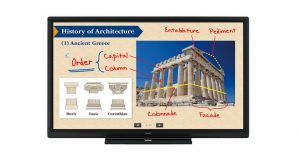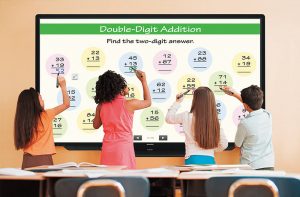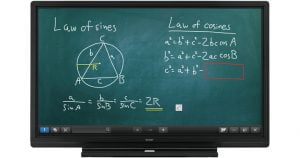Interactive Screens for Education
Overview
Overview:
Interactive Screens for Education
Interactive touch screens are increasingly popular in classrooms and are fast replacing traditional interactive whiteboards. Offering bright, crisp pictures in any lighting conditions without any shadows, with no lamps to change, the total cost of ownership is budget friendly.
 Midshire is a leading supplier of Sharp’s BIG PAD range of interactive screens for education, which forms a large part of our Audio Visual offering. Sharp has four bespoke interactive touch screen devices specifically designed for the education market.
Midshire is a leading supplier of Sharp’s BIG PAD range of interactive screens for education, which forms a large part of our Audio Visual offering. Sharp has four bespoke interactive touch screen devices specifically designed for the education market.
The PN-60SC5, PN-65SC1, PN-70SC5 and PN-80SC5 are 60”, 65”, 70” and 80” interactive touch screen devices, developed to meet the needs of the classroom.
Thanks to its 10-point multi-touch technology, based on Sharp’s industry-fastest, responsive and natural touch capability, the BIG PAD is a rewarding experience. Built with infra-red blocking detection technology, it allows for collaboration between as many as 4 users, simultaneously, allowing for un-paralleled collaboration. This creates a more rewarding and engaging classroom experience in all education settings.
The infra-red technology also removes the need for the biggest bug-bear in schools – calibration! The infra-red technology scans the surface and wherever you touch the screen, the infra-red beam is blocked, resulting in pixel perfect results, so you can be sure that your annotations are in the exact place you intended. Teachers no longer need to spend the first 10 minutes of the lesson calibrating the screen!
Bespoke features of Interactive Screens for Education
The two stand-out features are the Freeze-Frame and Blackout buttons for control, security and audience attention.
The Freeze-Frame button allows content to be frozen on screen, while the presenter continues using a connected device. This is ideal for the situation where students need to write down a large amount of content from the board, as it allows the teacher to plan for future lessons in the periods they are not presenting.
The Blackout button turns the screen black to instantly focus the class’s attention back to the teacher. It could also be used, for example, in maths lessons when the teacher shows a method on the board, and the students then need to utilize the method for their own questions.
Keep the curtains open!
Light reflection from windows means that interactive whiteboards that utilise projector technology can at times be unreadable. If watching video footage, the lights are often turned off and the curtains or blinds drawn. This is not conducive to teaching or learning, as it means that students can become tired and drowsy. Interactive Touch Screens in contrast are able to be used in broad daylight.
Wall-mounted or on a trolley?
 Interactive Screens for schools are able to be mounted on a wall or put on a moveable trolley. The trolley is ideal for primary schools where most classrooms are on a single floor and interactive screens are not necessarily needed for every lesson, allowing for the sharing of a few devices between multiple classes. In contrast, secondary schools and colleges tend to have a need for an interactive screen in every classroom, therefore wall-mounting the devices in this scenario is usually the preferred option.
Interactive Screens for schools are able to be mounted on a wall or put on a moveable trolley. The trolley is ideal for primary schools where most classrooms are on a single floor and interactive screens are not necessarily needed for every lesson, allowing for the sharing of a few devices between multiple classes. In contrast, secondary schools and colleges tend to have a need for an interactive screen in every classroom, therefore wall-mounting the devices in this scenario is usually the preferred option.
What about lesson plans?
The biggest fear teachers have is that when they upgrade to a new interactive touch screen, that they are going to lose all their previous lesson plans. However, with Sharp interactive screens for education, you can still have access to open architecture, which works with all software allowing you to access interactive whiteboard files, meaning that the day after the installation, you can carry on teaching as normal, with no need to spend hours upon hours re-designing all your lesson plans.
 Combining advanced high definition and touch screen technology with the ability to integrate with other devices through wireless connectivity, Sharp’s expertise and understanding ensures these benefits are intuitive. With the screens become easy to use, teachers can focus all their attention on teaching, not getting lost in the technology.
Combining advanced high definition and touch screen technology with the ability to integrate with other devices through wireless connectivity, Sharp’s expertise and understanding ensures these benefits are intuitive. With the screens become easy to use, teachers can focus all their attention on teaching, not getting lost in the technology.
Sharp’s industry leading interactive screens have ‘direct optical bonding’ technology as standard, due to the fact that the entire device is created in one factory. Direct optical bonding is the process of bonding the LCD panel with the protective glass touch layer with a thin layer of transparent gel-like glue. This ensures there is no air gap between the two layers, reducing the milkiness of the display and reduces the parallax differential, ensuring the delivery of precise touch and enabling users to see the screen from all angles.
Bring learning to life across all age groups with highly stimulating and engaging visual information. Teachers and students can collaborate and enjoy a more productive learning experience with interactivity enabled by Sharp’s BIG PAD.
Interactive Screens for Further Education
Combine up-to three Sharp interactive boards in a row, making an ultra-long display, ideal for lecture theatres. Coupled with the use of Sharp’s Display Connect, up to 50 devices can connect to the presenter’s screen, mirroring content, transferring files, or making their own annotations. The perfect setup for innovative, higher education establishments.
Speak to an Expert 03332 413 433
Remote Support
Our customer support help-desk technicians will guide you through the next steps,
to assist you with your query.
OneStop Login
(Formerly Callisto)

Search
